Development of an Optical Nano-Antenna!: How small can we make magical metal rods enhancing received radio waves?
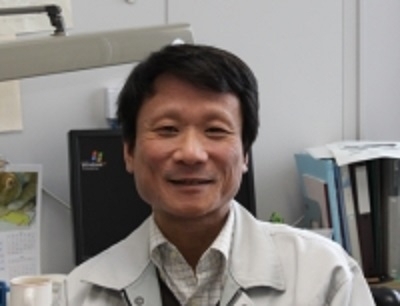
In this edition of Research NOW, we interviewed Professor Yutaka Kadoya, Semiconductor Quantum Optics Laboratory, Department of Quantum Matter, Graduate School of Advanced Sciences of Matter.
(April 27th, 2010, Interviewed by the Community Collaboration, Information Policy Office, and Public Relations Group)
Profile
Professor Kadoya and his research group developed a nano-optical antenna, an advanced version of the Yagi-Uda antenna(*1) which was devised in Japan already 80 years ago. Its function is based on the principle of the wave nature of light (the behavior of reflection and refraction of light.
On many houses’ rooftops all over the world, we can still see many Yagi-Uda antennas receiving TV-signals. Professor Kadoya’s new antenna, reduced in size to nano-scale, about a millionth size of conventional radio wave Yagi-Uda antenna which has strong directionality (the behavior of sending the electric waves in one single direction), allows high level directionality control of light.
The results of this study were published in the journal "Nature Photonics (Electronic Edition)" issued on March 14th. The work was also introduced in the online Nature News on March 14th. The printed version was published in May and this study appeared on the cover of the Journal.
(http://www.nature.com/nphoton/index.html)
(*1) TV-antenna, which is made of a set of parallel metal rods and looks like fish bones to transmit and receive radio waves and its name is derived from inventors.
Inspiration at coffee break
Professor Kadoya is a Director of the International Project Center for Integrated Research on Quantum Information and Life Science, which is one of the Project Research Centers in Hiroshima University. This Center was established in order to conduct researches integrating Quantum Mechanics and Life Sciences.One of research theme of the project center is bioluminescence. In general, however, the light emitted by living organism is very weak. Professor Kadoya was seeking to collect this weak light and to bundle it into one direction.
One of research theme of the project center is bioluminescence. In general, however, the light emitted by living His original field of research is photonic devices. He intended to solve this problem by laying out several nanometer-sized metal rods (1 meter = 1,000,000,000 nanometers), which is a structure he has been investigating. One day, drinking a cup of coffee, he had a chat with Holger Hofmann, an Associate Professor at the Graduate School of Advanced Sciences of Matter. He advised “To bundle light into one particular direction, why don’t you consider something like an antenna?” Light and radio waves are both electromagnetic waves. After that moment of inspiration, the development of an optical-antenna applying the Yagi-Uda antenna started in full swing.
Theoretically possible nanometer scale antenna
In a few days after the coffee break, Professor Hofmann developed a framework of a theory for the design of the antenna applicable to the optical antenna. Using the theory, the design of the optical Yagi-Uda antenna was performed easily.
However, it was very difficult to fabricate the antenna in line with the planned design.
For the Yagi-Uda antenna is designed adjusting to the characteristic of the radio waves to be received, each antenna is different in shape and size. In particular, the length of the metal rods must be scaled with the wavelength of the radio wave.
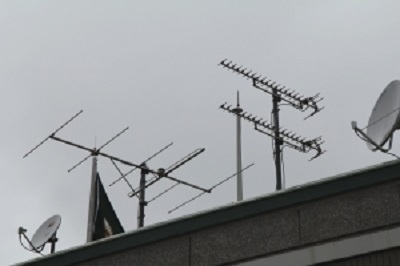
TV antennas on the rooftop of the Administration Bureau Building at the HU campus, The antenna with long rods on the left side is for VHF use, the antenna with short rods on the right side is for UHF use.
For example, as the antenna rod for UHF wavelengths (300MHz-3GHz) is shorter than that for VHF wavelengths (30MHz-300MHz), Optical wavelength is much shorter than radio wavelength (about a millionth of UHF wavelength). Moreover, the nature of metal making up antenna in optical field is different from that in radio waves. For this reason, they have to fabricate much smaller antenna. The newly developed antenna is so small that we cannot find the shape even if we maximally magnify the image through an optical microscope.
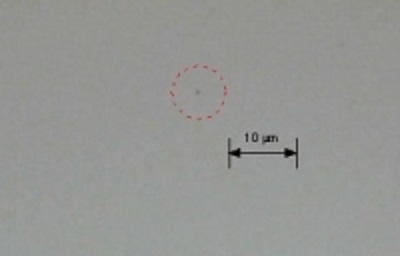
The optical antenna viewed through an optical microscope (the black dot in the middle of the red circle is the optical antenna)
To develop such a tiny antenna, an electron beam lithography was used. For example, integrated circuits (ICs) of modern electronics are usually fabricated using optical lithography, which is a device using lightwaves. Electron beam lithography is a better device for such extremely fine works because it uses electron beam which can be a sharper knife than the lightwaves.
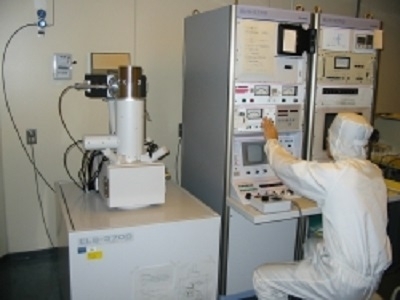
The electron lithography equipment
Why are such fine works necessary? It is because every antenna rods, even the smallest one, must have a correct shape and ratio between length, width, and height to work properly as the antenna elements.
Mr. Terukazu.Kosako, who was a doctoral student at that time and is now working for the Shinoda Plasma Co. Ltd., tackled this tough work. With the guidance and support of Professor Kadoya, at last he realized the antenna after one year of hard work. He mentioned that it was especially difficult to adjust the height (or thickness) with such narrow width.
Optical antenna was completed!
This is a picture of the optical antenna taken by an electron microscope.
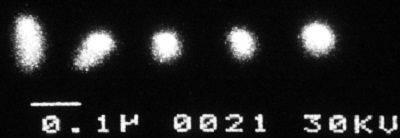
The optical antenna on a microscopic slide (picture taken by an electron microscope)
The size of the completed optical antenna is only a millionth of an average Yagi-Uda antenna. It consists of five 75-125 nm length golden rods within a dimension of 500 nm.
As it is extremely small, we can’t see it clearly even with an electron microscope. But it is fairly visible that the rod second from left is tilted. This tilt is very important. Be applied small external stimulus (red light with a wavelength of 662nm) to this tilted element, it excite the other elements, then emits a strong light in one definite direction.
This nano-scale antenna makes it possible to enhance both emission and detection of light from nano-scale light sources (individual molecule and semiconductor quantum dot). It also enables to measure and recognize even extremely weak light using the sensor, and to analyze molecule effectively using light. In future, optical communication between molecules will be expected. It leads to improve the performance of a single photon source (a device to generate single photons which is particles of light) for quantum computers and quantum communication expected as a future information and communication technology.
Professor Kadoya, talking about the possibilities of the optical antenna
The long way to measurement
Although the antenna was fabricated successfully, it was again very difficult to measure if the antenna really emits light only in one definite direction. As the antenna itself is very tiny and emits light only in a very limited direction, it is very hard to specify the position to measure. With strong support of Mr. Hiroshi Taniguchi, a technical staff in HU Technical Center, Mr. Kosako developed a special instrument shown as this picture. Failed again and again, he finally succeeded in demonstrating the optical Yagi-Uda antenna working well after one year since they fabricated the antenna.
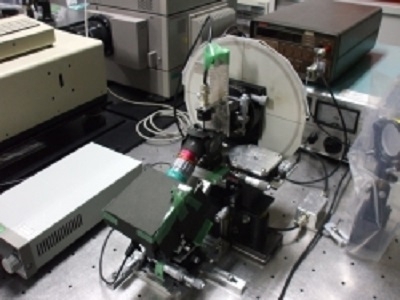
The measuring instrument developed by Mr. Kosako
Hiroshima University- born technology: Spreading your wings around the world?
One of Professor Kadoya’s teaching principles is that “students should make presentations at higher level academic conferences including international ones”. In fact, every year 2-3 students present their research results at the international conferences. Mr.Kosako presented this research result of his at the most prestigious international conference in this field. He was also awarded the Presentation Encouragement Prize of the Japan Society of Applied Physics.
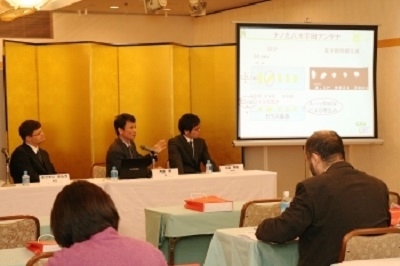
The press conference held by Nature Photonics (in Tokyo). (Photo by Chris Gilloch).
From left to right: Associate Professor Hofmann, Professor Kadoya and Mr. Kosako
Afterword
Despite I had little knowledge of science, Professor Kadoya started with explaining me the phenomena of light. His explanation was very polite and easy to understand, and I was surprised and said words like “Really”, “Unbelievable!” again and again, I got caught up in Professor Kadoya’s talk. He talked about something invisible however I could imagine the golden antenna on the microscopic slide when I listened to his explanations. He said “Students are also full- fledged researchers. In my laboratory, we are equal. Of course, I teach them, but I really like the present atmosphere in which we can conduct researches with freewheeling thinking”. Go back to basics and develop a new type of optical device, which is a tradition inherited from Former Professor Masamichi Yamanishi (Emeritus Professor, Former Vice President) and it has been passed on to younger generations. “That’s Hiroshima University brand!” These words flashed across my mind. It was my first work as research reporter and I was very excited, but in the end I felt pleasant and happy. (T2)


 Home
Home

